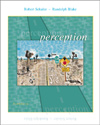| apparent motion | The illusory impression, created by the rapid alternation of objects presented at different spatial locations, that the objects have moved smoothly from one location to the other. See element movement, group movement.
|
 |
 |
 |
| critical flicker frequency (CFF) | The highest perceptible rate of temporal variation in light intensity.
|
 |
 |
 |
| direction-selective cell | A neuron in the visual cortex that responds most vigorously to a particular direction of target movement.
|
 |
 |
 |
| element movement | In an ambiguous type of apparent movement, the percept that some of the stimulus’s components are stationary while one component moves back and forth. See apparent motion, group movement.
|
 |
 |
 |
| global motion | The experience of motion in a single direction that arises from a stimulus whose elements move in a variety of different directions.
|
 |
 |
 |
| group movement | In an ambiguous type of apparent movement, the percept that all stimulus components move back and forth en masse (as a group). See apparent motion, element movement.
|
 |
 |
 |
| induced motion | The illusory impression, created when moving contours are nearby a stationary object, that the stationary object is moving.
|
 |
 |
 |
| motion aftereffect (waterfall illusion) | The illusory impression, after prolonged viewing of movement in one direction, that a stationary object is moving in the opposite direction.
|
 |
 |
 |
| motion capture | An object that moves in one direction over a field of randomly moving elements causes those elements to appear to move in the same direction as the object itself.
|
 |
 |
 |
| optic ataxia | A neurological disorder characterized by difficulties in the visual guidance of limb movement.
|
 |
 |
 |
| proprioception | The sense that enables one to feel where one’s limbs are.
|
 |
 |
 |
| pursuit eye movements | Smooth movements of the eyes that allow them to follow a moving target.
|
 |
 |
 |
| saccades | Rapid, jerky movements of the eyes, which function to change fixation from one location to another.
|
 |
 |
 |
| smooth eye movements | Smooth movements of the eyes, which can function in the pursuit of a moving target.
|
 |
 |
 |
| structure from motion (SFM) | The impression of an object’s shape that derives from the object’s motion.
|
 |
 |
 |
| waterfall illusion | See motion aftereffect.
|



 2002 McGraw-Hill Higher Education
2002 McGraw-Hill Higher Education

 2002 McGraw-Hill Higher Education
2002 McGraw-Hill Higher Education